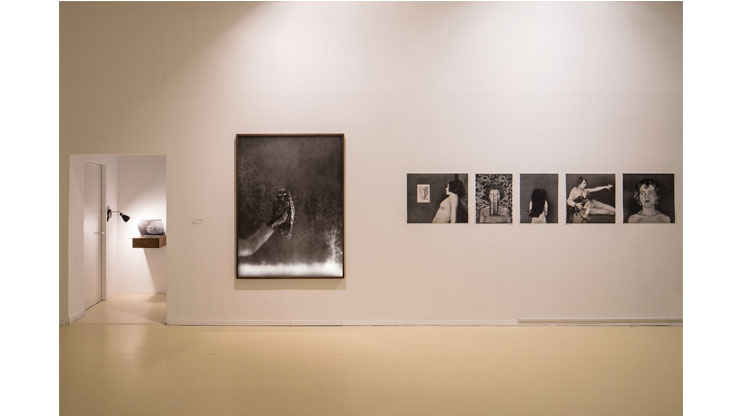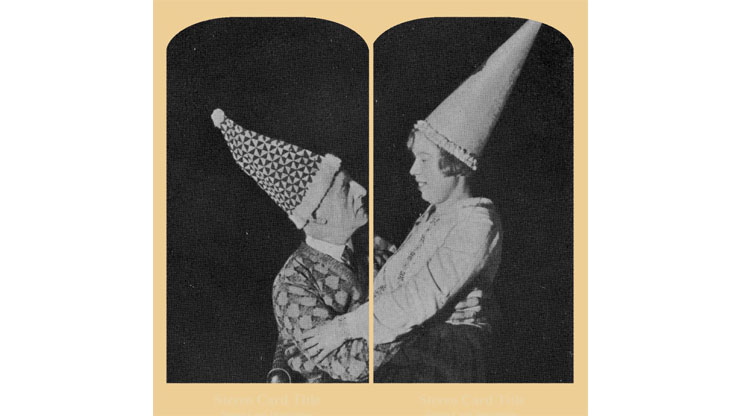
Mr. Ulbrich and Miss Neumann’s story serves as a starting point for the project developed by Ronit Porat (born 1975, Kibbutz Kfar Giladi). In this story, evoked from the annals of history, she stresses a twofold perspective – man and woman, victimizer and victim, photographer and model. This duality is reproduced in her installation not merely in the duality inherent in the medium of photography but also in the presentation of the images in the stereoscopic mechanism of a Kaiserpanorama.1 Invented by August Fuhrman in Germany in 1883, eighty years prior to the murder at hand, this optical device combines the tradition of painted panorama rooms with elements of the peep-show phenomenon and the medium of photography. Marketed as a popular recreation form, it was used to view stereoscopic photographs.2
The first model included 25 viewing stations arranged around a circular device. A rotating mechanism changed the image every couple of minutes, and so the entire viewing experience – a panoramic voyage through exotic landscapes, scientific findings, and news flashes – lasted almost an hour.3
In Porat’s exhibition two parallel narratives are presented. One, within the Panorama device, retraces imaginary or unconscious events in Ulbrich’s darkroom. The other narrative, outside the device, relates the story of Neumann as a female model who turned from victim to victimizer, from a voyeuristic object to murderer. The two narratives are presented like a Möbius strip that extends into and out of the device – on the walls of the surrounding space and within the Panorama – thereby suggesting a possible reversal of roles between exterior and interior, between Neumann and Ulbrich.
Kaiserpanoramas, these “aquariums of distance and past,” as Walter Benjamin once called them,4 are underlain by longing for the object viewed. Upon entering the device the viewer becomes part of it, captivated by the perspective and images set before him – objects of dreams, memory, or desire, which command his full attention. Yet this immersion is not absolute, since, accompanied by the mechanical sound of the rotating mechanism, the images keep changing, lending the viewing a fragmentary aspect.5 This sense of fragmentation informs Porat’s installation, which does not present an organized archive documenting the story but rather something recalling a crime scene, which does not allow one to have a whole, panoramic perspective and only enables selective zigzagging between details.
Porat’s Panorama is in dialogue with Ulbrich’s urges and voyeurism. She animates the images of the girls he photographed, which, seen within the stereoscopic device, turn three-dimensional; like ghosts brought back to life momentarily, just until the image display changes once again. This form of display gives substance to the girls’ lives while, at the same time, proclaiming their absence. In addition, the viewer is not alone in watching the images in this device; rather, one is always in close proximity to other viewers. That is, voyeurism is constructed as an activity that is both intimate and shared, private and public, in which each viewer also views his fellow viewers’ voyeurism.
Consequently, there is also a reversal of roles between voyeur and object of voyeurism, viewer and viewed. Such voyeurism, which purportedly endows photography with validity as a judicial and moral witness at the aid of crime solving, also accentuates the gap between “images of reality” and their modes of production and reading. This is accompanied by a presentation of portraits of Ulbrich’s victims on the wall outside the device, which brings to mind a line-up of mug shots or forensic evidence. This presentation confirms their status both as victims and as witnesses who have a responsibility to report a crime.
Oscillating between an overall perspective and one focused on details and fragments, Porat’s installation examines the ways by which information is imparted to us. Such oscillation is inherent in the Panorama itself, which endeavors to offer a general view with as many details as possible, seemingly refraining from editing and hierarchy. Another duality that is part of the Panorama and reverberates in Porat’s installation has to do with the viewer’s stance vis-à-vis the display, which by its very existence as representation declares the inaccessibility of the event itself. Thus it establishes tension between the scene, presented in its entirety, and the changing perspectives of the viewer within a given space; between vision, which establishes definite data, and movement, which construes knowledge as relative. Another kind of relativity is manifested in the double portrait that depicts Ulbrich possessively clutching the breasts of the girl by his side (who is not Neumann).
Ulbrich, the victimizer, does not look at the camera, perhaps eschewing blame, but rather turns his gaze on the girl. She, however, looks straight at the photographer (that is, Ulbrich) and possibly also at the picture’s future viewers – witnesses, jury – who are complicit in the act of voyeurism.
1 The device was called by different names in different times, including Imperial Panorama, Diorama Imperial, Weltpanorama, and in the Polish version, Fotoplastikon.
2 The Imperial Panorama became popular in Europe from the very beginning, and August Fuhrman sold and operated some 250 devices in Germany, Austria, and other countries. See Bernard Comment et al, The Panorama (London: Reaktion Books, 1999), p. 71.
3 The number of viewing stations and the show’s duration varied a little. See Jonathan Crary, Suspensions of Perception: Attention, Spectacle, and Modern Culture (Cambridge, Mass: MIT Press, 1999), p. 136.
4 See Alex Coles (ed.), The Optic of Walter Benjamin, vol. 3 (London: Black Dog Publishing, 1999), p. 60.
5 Crary, Suspensions of Perception, p. 138.

Less Reading...

